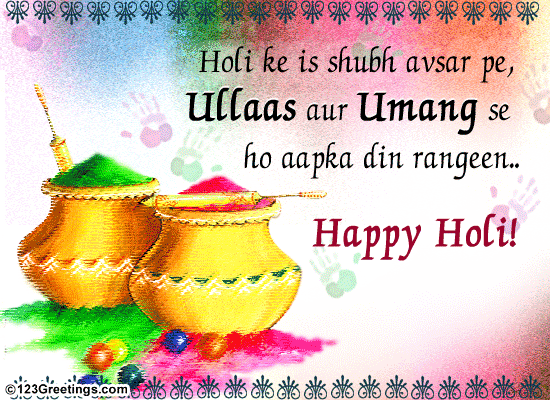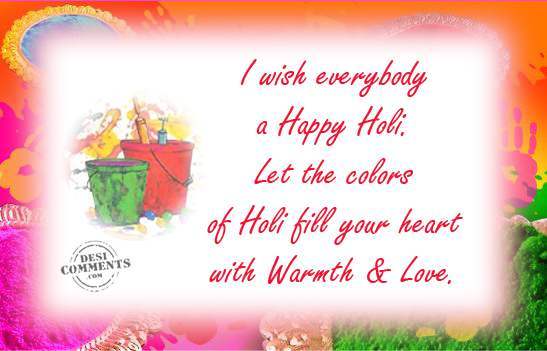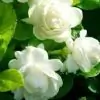HAPPY HOLI
Dulhendi { Traditional Holi }
The colourful festival of Holi is celebrated by different names in this vast and culturally diverse country. The traditions followed for the festival varies a little and at times a lot as one moves from one state to other studying the various facets of the festival and getting behind the various colours of it.
Nowhere it is celebrated with so much charm and enthusiasm as in Mathura, Vrindavan, Barsana and Nandgaon - the places associated with the birth and childhood of Lord Krishna. At Barsana Holi assumes the name of Lathmaar Holi. Here, women of Barsana give a tough time to men of Nandgaon as they come to play Holi with them. Women drag the unlucky captives, beat them, dress them in a female attire - yet all is in the spirit of Holi.
Women of Haryana, specifically the bhabhis too get an upper hand on the day as they get a social sanction to beat their devars and take a sweet revenge for all the mischiefs they have played on them. This revengeful tradition is called the Dulandi Holi.
The most enjoyable tradition of Holi, of course, apart from the play of colours is the tradition ofbreaking the pot. It is celebrated with much fan fair in the states of Maharashtra and Gujarat. Here a pot of buttermilk is hung high on the streets. Men form a huge human pyramid and one on the top breaks the pot with his head. All this while women keep singing Holi folk songs and throwing buckets and buckets of water. The tradition has its roots in the mischievous nature of Lord Krishna who was so fond of butter milk that he used to steal it from every accessible house in the village. To hide the butter from young Krishna, womenfolk used to hang it high. All in vain!
Holi is celebrated in the most dignified manner in the state of Bengal. At Vishwa Bharti University, founded by Rabindranath Tagore founded the tradition of celebrating Holi as 'Basant Utsav' or'Spring Festival'. Students decorate the campus with intricate rangolis and carry out prabhat pheris in the morning. Clad in a traditional attire young boys and girls sing songs composed by Gurudev and present an enchanting view to the onlookers who gather in large number here. In other parts of Bengal, Holi is celebrated as Dol Yatra where the idols of Radha and Krishna are placed on a decorated palanquin and taken out in a procession.
For Sikhs, Holi calls for the display of their physical strength and military prowess as they gather at Anandpur Sahib a day after Holi to celebrate Hola Mohalla. The tradition was started by the tenth and last guru of Sikh religion, Guru Gobind Singh ji and is being religiously carried forward.
In the north east, Manipuris celebrate the festival in a colourful manner for six continuous days. Here, the centuries old Yaosang Festival of Manipur amalgated with Holi with the introduction of Vaishnavism in the eighteenth century. The highlight of the festival here is a special Manipuri dance, called 'Thabal Chongba'.
Well, there are many-many more ways in which Holi is celebrated. Different states, different cities and different villages have come out with their unique and innovative styles of playing Holi. It may not be possible to describe all of them at one place. What is noteworthy though is the fact that the spirit of Holi remains the same throughout. It is the festival which generates the spirit of brotherhood and bring people close - and this is what matters most than anything else.
What enhances the spirit of Holi though is the tradition of consuming the intoxicating bhang. It is generally consumed with thandai or as pakoras. People go high on it and enjoy the festival to the hilt. Other Holi delicacies include gujiya, mathri, malpua, puranpoli, dahi badas, etc. After a frenzied play of colours people love to gorge them up.

Meaning of Colors
Red symbolizes: action, confidence, courage, vitality
Pink symbolizes: love, beauty
Brown symbolizes: earth, order, convention
Orange symbolizes: vitality with endurance
Gold symbolizes: Wealth, prosperity, wisdom
Yellow symbolizes: wisdom, joy, happiness, intellectual energy
Green symbolizes: life, nature, fertility, well being
Blue symbolizes: youth, spirituality, truth, peace
Purple symbolizes: Royalty, magic, mystery
White symbolizes: Purity, Cleanliness
Black symbolizes: Death, earth, stability
Gray symbolizes: Sorrow, security, maturity
Holi Safety Tips
Here are a few tips and suggestion to make your holi safe and joyous.
- Play safe. Don't get to boisterous and do not let others to be rude on you.
- The best option would be to play with natural home made colours. Your skin and hair will feel tampered with the use of skin friendly natural products.
- If natural colours are not possible, then ensure a better quality of colours. Buy colours from a reputed shop or vendor.
- Use more of red or pink colours which looks good and can easily taken off. Gaudy purple, green, yellow, orange have more harmful chemicals in them and should be avoided.
- Make sure that your face is well creamed before and after the play.
- Apply thick coating of paint on your nails- both in fingers and toes so that they remain protected.
- Oil your hair well, so that colour doesn't stick on your hair and can be washed off easily later.
- Cover your hair. Make use of hat or caps to protect your hair from being coloured with hard-to-rinse dyes.
- Make sure that powder or any other product does not get inside your eyes. Eyes are extremely vulnerable on Holi because of their strategic place in body and also because of the use of harmful chemicals in colors these days. Please ensure that your eyes remain protected at all times. Use a sunglass to protect your eyes from a misfire of colour filled darts or water jets.
- Use dental caps to save your teeth from any unwanted stains.
- Put on your worst clothes so that you won't have to take on the hassles of an immediate washing.
- Rags like tattered denims and bright shades like black, blue, green, purple are highly recommended.
- Try to save yourself off from all possible attacks on the face. In case your such attempts fail, keep your eyes and lips tightly shut if you are attacked on your face.
- If possible avoid going outside your home, atleast for the peak hours of celebration. The premises of your home ensure that you are safe from pouncing hooligans, even friends who can be a little rough on the day.
- When traveling keep the car windows thoroughly shut, even if you don't have an AC car. Do not bump into the frenzied group of mob if you take to streets. Better you cross the road to the sidewalk across. Or, simply stay at a safe distance.
- Do not use permanent dyes. If someone has applied it on you, do not rub the face with soap immediately in order to get rid off it, especially when it is wet. Instead, use good qualitycleansing milk for removal. It's better than using soap, which will dry up your skin.
- Rotten eggs when thrown on your head, flying missiles from locality buildings'are still not too bad, will be smelly yet is a good conditioner for your hair. But tar, shit, Mobil, stones and all the rubbish that you can be hit with is not. Avoid being a prey to hooligans.
- Remember you also have police on your side and if any untoward revelers misbehave, you can make your complaint. Mark out the locality, building and if possible the person.
- Take a bath much later after the entire Holi celebration is over. Taking frequent baths, washing the face again and again, will ruin your skin. You will also lose hair, for too much soap/shampoo has a drying effect.
- If you are prone to skin allergies, avoid playing with gulal altogether. Going to a dermatologist (skin specialist) serves no purpose, after the damage is done.
- Avoid running on jumping on wet floors, so that you don't slip and injure yourself. Bones are specially vulnerable on this day.
- Avoid over indulgence in bhang, drinks or food... so that you don't repent later.
- Do not drive if you are high on alcohol or bhang.
- Keep handy pain killers, anti-oxidants, anti-allergic tablets if all the above tips have been disregarded.




































